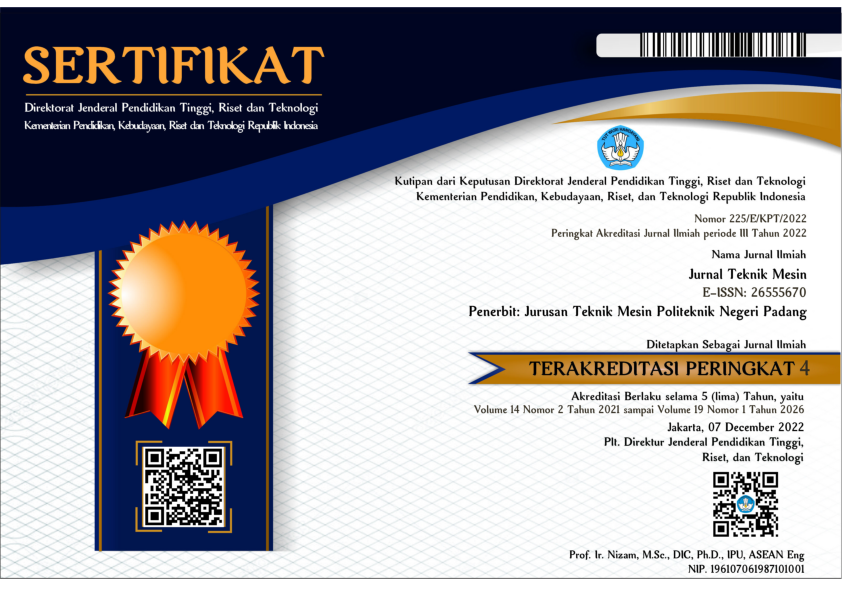Perancangan Mesin Penggiling Padi dan Penepung Sekam Padi Skala Rumah Tangga
Abstract
Rice milling machines and rice husks that are in the community have helped a lot for farmers in terms of rice milling. From the data obtained after conducting the survey, it was found that the rice milling machine and rice husk flour had several shortcomings, including large size and requiring large space, also having a relatively expensive price. To produce bran requires two processing machines, so it is less effective because it takes a long time. The purpose of designing this machine is to combine two milling and flour systems into one to be efficient, and to design a machine with a small size so that manufacturing costs are affordable to farmers. The machine is designed to be operated using the power of a gasoline driving motor which is converted to a mill and flour movement for a one-time rice capacity of 15 Kg and 5 Kg of rice husks. The motor power is 5.5 HP with engine speed of 3600 rpm. The machine uses 3 pulleys with a size of 3 inches, 7 inches, 4 inches and there are 2 V-belts with a length of 76.89 inches and 63.48 inches so that the rotation of the motor which is originally 3600 rpm is reduced by the pulley engine speed to 1500 rpm and 2000 rpm. For the calculation of the pegs, the pin length of the mill shaft is 7.4 mm and the length of the peg shaft is 17 mm. The selection of bearings on the grinding shaft is bearing number 6204 and on the flour shaft bearing number 6202. This rice mill and rice husk flour machine has frame dimensions of 440 mm x 430 mm x 940 mm. Overall, the design results data are declared to fulfill the requirements to be designed and built.
References
Badan Pusat Statistik, 2017. Luas Panen, Produktivitas, dan Produksi Padi Sawah (GKG) di Kabupaten Karawang. [Online] (Updated 4 Jan 2017) Tersedia di: https://karawangkab.bps.go.id [Accessed 12 Feb 2020]
Muhazir, A., dan Widyantoro, M., 2018. Perancangan dan Pembuatan Mesin Pengolahan Limbah Sekam Menjadi Bahan Baku Pakan Ternak. Jurnal Kajian Ilmiah, 18 (2), 95-103.
Sumiyarso, B., 2015. Rancang Bangun Mesin Penggiling Gabah dan Pemutih untuk Skala Rumah Tangga dengan Kapasitas 30 Kg/Jam. Jurnal Rekaya Mesin, 10 (1), 21-25.
Windarta., dan Amami, E., 2016. Rancang Bangun Mesin Pemisah Padi Isi dengan Padi Kosong Kapasitas 10 Kg/Menit. Fakultas Teknik UMJ, Seminar Nasional Sains dan Teknologi. Jakarta, 8 November 2016. Universitas Muhammadiyah Jakarta: Jakarta.
Hersetianto, A., dan Yunus., 2015. Mesin Penggiling Janggel Jagung untuk Bahan Baku Pakan Ternak. Jurnal Rekaya Mesin, 3 (1), 26-32.
Basori., Marsudi., Saputra, B.R., 2018. Perancangan Mesin Perontok Jagung dengan Kapasitas Produksi 300 Kg/Jam. Jurnal Konversi Energi dan Manufaktur, 5 (1), 7-14.
Suudi, A., Tanti, N., Akmal, J., Hasymi, Z., dan Budiyanto, P., 2019. Perancangan Mesin Penghancur Sekam Padi dengan Poros Penggerak Horizontal. Jurnal Teknik Mesin Indonesia, 14 (2), 37-41.
Sonawan, H., 2019. Perancangan Elemen Mesin. Edisi Revisi. Bandung: Alfabeta.
Abdullah, M., 2016. Fisika Dasar I. PDF. Bandung: Institut Teknologi Bandung.
Niemann, G., dan Winter, H., 1992. Elemen Mesin Jilid II. Edisi Kedua, terjemahan Anton Budiman dan Bambang Priambodo. Jakarta: Erlangga.












